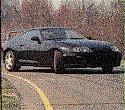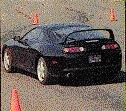

| Consumer |
|---|
| Exploring the Upper Limits |
Toyota Supra TurboIts not that we expect many of our readers to plonk down $48,000 for a supercar seemingly designed to go from here to there at triple the speed limit. Rather, we tested the Toyota Supra Turbo along with the sports coupes in the proceeding report to see how much extra performance you get for more than twice the money. More specifically, we wanted to see whether this models exotic technology would raise any of our performance benchmarks. The Supra Turbo didn't disappoint. It provided blistering acceleration and handily broke our records for stopping distance on dry pavement and for outright cornering grip on our skidpad. The Supra started life in 1979 as an upscale version of the modest Toyota Celica, becoming a true high performance sportscar only after a mid-1993 redesign. The non-turbo 3.0 liter six, at 220hp is certainly potent enough. But the version we tested with twin intercooled turbos, cranks out an awe-inspiring 320hp. A six speed manual transmission and limited slip differential, along with traction control, transfer the power to massive, ultra-low profile rear tyres that measure 10 inchs across. The result is a 0 to 60 mph time of 5.9 seconds - within 0.4 second of the record set by the Chevrollet Corvette we reported on in September 1992. Two other excellent sportscars that we reported on in that issue, the Nissan 300ZX Turbo and Mazda RX-7, trail with 0 to 60 mph times of 6.1 and 6.0 seconds. A peppy family car might take 9 or 10 seconds. Expect the Toyota Supra to deliver about 22 mpg overall on premium fuel. At our track, we had merely to point the Supra and shoot it from corner to corner. Only the width of its body limited the speed through our avoidance maneuver. The steering is quick but lacks much feel. The ride is harsh and noisy. Anti-lock brakes halted the Supra from 60mph in just 114 feet on dry pavement, breaking the 1993 Pontiac Firebird Trans Am's and Volvo GLT's record by four feet. The Supra stopped short and straight in our wet braking tests as well - an excellent performance. Despite a height adjustment, the low drivers cushion impedes the view over the hood. Firm front seats provide strong support but climbing in and out requires agility. Dual airbags are standard. The rear seat is far too cramped for adults, and the pockets in the rear seats are to narrow for a child seat. The trunk is extremely shallow. Although we lack reliability data for the redesigned Supra, other Toyota models have held up exceptionally well. The Nissan 300ZX's predicted reliability is average. We lack sufficient data to predict the Mazda RX7's reliability. The Chevrolet Corvette promises to be much worse than average. The Supra Turbo scored higher overall than any other sports car we've tested, but its sole relentless objective is to go very fast indeed. The Nissan 300ZX makes a few more concessions to comfort - and over the long haul, its a bit easier to live with. There's also the matter of price. Our Supra Turbo with removable roof panel, leather upholstery, premium stereo/CD player and rear spoiler lists for $47,975. The Nissan Turbo costs some $6000 less. |
| Test Data | |
|---|---|
| Acceleration | Seconds |
| 0-30 mph (0-48 km/h) | 2.8 |
| 0-60 mph (0-97 km/h) | 5.9 |
| Quarter Mile | 14.4 @ 105 mph (169 km/h) |
| 45-65 mph (72-105 km/h) | 4.0 |
| Fuel Economy | mpg |
| EPA | 17/23 |
| CU's 150 mile trip | 24 |
| City Driving | 15 |
| Expressway Driving | 33 |
| Fuel refill capacity (galls) | 15.4 |
| Cruising Range (miles) | 340 |
| Fuel for 15000 miles (galls) | 690 |
| Cost of fuel for 15000 miles | $965 |
| Braking from 60 mph | feet / lb |
| Dry Pavement | 114 |
| Wet Pavement | 136 |
| Pedal Effort, 1st stop | 10 |
| Pedal Effort (10th stop) | 15 |
Back to Home Page